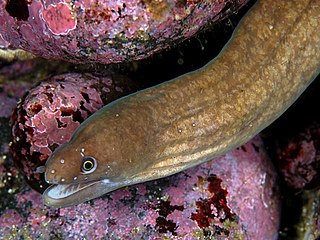
Moray eels, or Muraenidae, are a family of eels whose members are found worldwide. There are approximately 200 species in 15 genera which are almost exclusively marine, but several species are regularly seen in brackish water, and a few are found in fresh water.

Ophichthidae is a family of fish in the order Anguilliformes, commonly known as the snake eels. The term "Ophichthidae" comes from Greek ophis ("serpent") and ichthys ("fish"). Snake eels are also burrowing eels. They are named for their physical appearance, as they have long, cylindrical, snake-like bodies. This family is found worldwide in tropical to warm temperate waters. They inhabit a wide range of habitats, from coastal shallows and even rivers, to depths below 800 m (2,600 ft). Most species are bottom dwellers, hiding in mud or sand to capture their prey of crustaceans and small fish, but some are pelagic.

The superorder Elopomorpha contains a variety of types of fishes that range from typical silvery-colored species, such as the tarpons and ladyfishes of the Elopiformes and the bonefishes of the Albuliformes, to the long and slender, smooth-bodied eels of the Anguilliformes. The one characteristic uniting this group of fishes is they all have leptocephalus larvae, which are unique to the Elopomorpha. No other fishes have this type of larvae.

Gymnothorax is a genus of fish in the family Muraenidae found in Atlantic, Indian, and Pacific Oceans. With more than 120 species, it the most speciose genus of moray eels.

Anarchias is a genus of moray eels in the family Muraenidae.

Strophidon is a genus of eels in the family Muraenidae. The genus has a wide distribution throughout the Pacific and Indian Oceans where they mostly inhabit the benthic zone.

Anarchias leucurus is a moray eel found in the Pacific Ocean. It was first named by Snyder in 1904 as Uropterygius leucurus, and is commonly known as Snyder's moray, the fine-spotted moray or the finespot moray. It is thought to be the smallest species of moray, and may actually represent several different species or subspecies.
Scuticaria okinawae is a moray eel found in the Pacific and Indian Oceans. It is commonly known as the shorttailed snake moray, shorttail moray, Seale's moray eel, or the Bennett's moray.

Scuticaria tigrina is a moray eel found in coral reefs in the Pacific and Indian Oceans. It is commonly known as the tiger reef-eel, tiger snake moray, tiger moray eel, tiger moray, tiger eel, spotted eel, or the spotted snake moray. It has distinctive black spots and stripes resembling tiger marks and is known to camouflage within the reef environment.
Uropterygius fasciolatus is a moray eel found in coral reefs in the western central Pacific Ocean. It was first named by Regan in 1909, and is commonly known as the blotched moray, barred moray, or the Gosline's snake moray.
Uropterygius xenodontus is a moray eel found in coral reefs in the Pacific Ocean. It is commonly known as the black snake moray, strange-toothed snake moray, or the wedge-tooth snake moray.
Uropterygius macrocephalus is a moray eel found in coral reefs in the Pacific and Indian Oceans. It is commonly known as the needle-tooth moray, large-headed snake moray, largehead snake moray, largehead moray, longhead moray, or the snowflake eel. It is used sometimes in aquariums.
Uropterygius macularius is a moray eel found in coral reefs in the western Atlantic Ocean. It is commonly known as the marbled moray.

Uropterygius marmoratus is a moray eel found in coral reefs in the Pacific and Indian Oceans. It is commonly known as the marbled reef-eel, marbled eel, marbled snake moray, marbled moray, or the slender conger eel.
Uropterygius inornatus is a moray eel found in the western Indian Ocean and in the Pacific Ocean to Hawaii. It is commonly known as the drab snake moray or black snake moray. It is faded tan in colour. First described by W.A. Gosline in 1958, this eel typically resides in tropical marine environments and is reef-associated, often found in shallow lagoons or seaward reefs at depths of 8 to 18 meters.
The mud-dwelling moray is a species of eel in the family Muraenidae, and the only species in the monotypic genus Diaphenchelys. It was described by John E. McCosker and John Ernest Randall in 2007. It is a marine, tropical eel which is known from Indonesia, in the western Pacific Ocean. It dwells at a depth range of 15 to 32 metres, and inhabits muddy bottoms, from which its species epithet, "pelonates", is derived. Males can reach a maximum total length of 46.5 centimetres (18.3 in).

Apterichtus is a genus of fish in the family Ophichthidae. Many of its species are called finless eels.

Ophichthus is a genus of eels in the snake eel family Ophichthidae.

Scolecenchelys is a genus of eels in the snake eel family Ophichthidae.
Skythrenchelys is a genus of eels in the snake eel family Ophichthidae.












